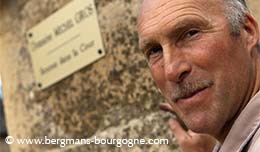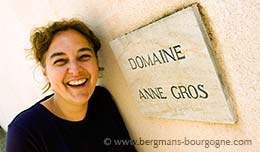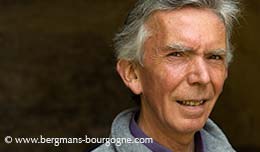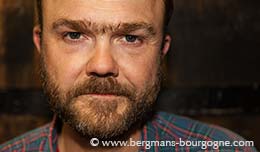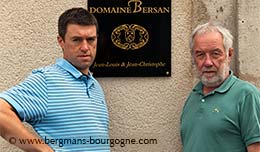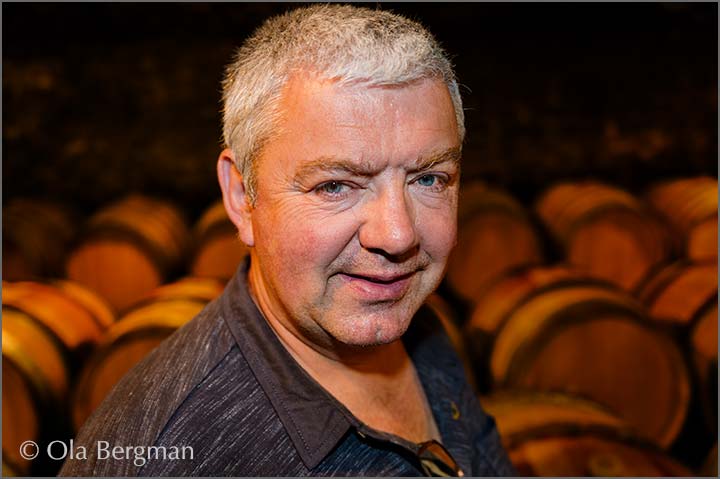
hilippe Gavignet has three premier crus in Nuits-Saint-Georges. But it is a Bourgogne Hautes-Côtes de Nuits, together with one of the premier crus, Les Chaboeufs, he considers to be the flagships of the domaine.
– Our Bourgogne Hautes-Côtes de Nuits comes from Clos des Dames Huguettes, he says. It is just above Nuits-Saint-Georges, next to the TV tower. It is a wine with focus on fruit, finesse and elegance. It is never a monster in terms of power.
Domaine Philippe Gavignet has close to one hectare of Dames Huguettes, spread over three parcels. In total the domaine covers 13 hectares, with the majority of the vineyards within the commune of Nuits-Saint-Georges.
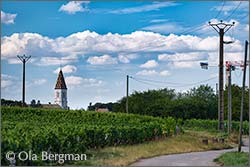 – We have 14 appellations, says Philippe Gavignet. Almost all vineyards are in Nuits-Saint-Georges. Even the Bourgogne and the Hautes-Côtes de Nuits. The only exception is half a hectare of Bourgogne Aligoté in Magny-lès-Villers. It’s very convenient, but at the same time it makes me more vulnerable when there is hail or frost and I have all my vineyards in the same village.
– We have 14 appellations, says Philippe Gavignet. Almost all vineyards are in Nuits-Saint-Georges. Even the Bourgogne and the Hautes-Côtes de Nuits. The only exception is half a hectare of Bourgogne Aligoté in Magny-lès-Villers. It’s very convenient, but at the same time it makes me more vulnerable when there is hail or frost and I have all my vineyards in the same village.
In a few years time there will be more Hautes-Côtes de Nuits cuvées at the domaine. Together with his son Benoît, who joined him at the domaine in 2014, he has been clearing scrubland and planting up-slope from Clos de la Maréchale and Clos Arlot.
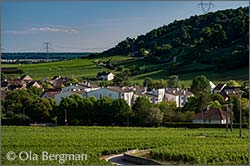 – The mayor of Prémeaux asked me if I was interested, because none of the young growers of the village wanted to plant up there. There will be three new Hautes-Côtes de Nuits. La Montagne in both red and white, and Clos de l’Hermitage in red. If you are in these places or in Dames Huguettes the Hautes-Côtes is good. If you are further up, say in Arcenant or Bévy, the grapes do not always ripen as they should. In Dames Huguettes I often harvest parts before I harvest some parcels in Nuits-Saint-Georges.
– The mayor of Prémeaux asked me if I was interested, because none of the young growers of the village wanted to plant up there. There will be three new Hautes-Côtes de Nuits. La Montagne in both red and white, and Clos de l’Hermitage in red. If you are in these places or in Dames Huguettes the Hautes-Côtes is good. If you are further up, say in Arcenant or Bévy, the grapes do not always ripen as they should. In Dames Huguettes I often harvest parts before I harvest some parcels in Nuits-Saint-Georges.
Les Chaboeufs is one of the premier crus south of Nuits-Saint-Georges, squeezed in between Les Vaucrains and Les Perrières.
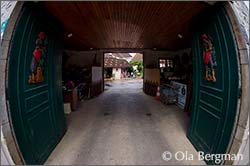 – It’s not very well-known, because it’s only 2.08 hectares, says Philippe Gavignet. My great-grandfather owned 1.5 hectare. He had three sons, so they received half a hectare each. My parents bought half a hectare from Maison Morin in 1982, which is now Boisset. Domaine Jean-Jacques Confuron in Prémeaux has some Les Chaboeufs too, as well as a cousin of mine.
– It’s not very well-known, because it’s only 2.08 hectares, says Philippe Gavignet. My great-grandfather owned 1.5 hectare. He had three sons, so they received half a hectare each. My parents bought half a hectare from Maison Morin in 1982, which is now Boisset. Domaine Jean-Jacques Confuron in Prémeaux has some Les Chaboeufs too, as well as a cousin of mine.
– Les Chaboeufs always has this slightly peppery, spicy character. The grapes are always very ripe there. Some years you get a wine which almost resembles a Côte-Rôtie. It has more finesse than Les Bousselots, which is more austere when young. Half of the vines were planeted in 1951. The other half in 1990 and 1994. The soil in Les Chaboeufs is not as deep as in Les Pruliers for instance. In Les Chaboeufs you have about 40 centimetres of soil, with much limestone.
Philippe Gavignet had a tough start in the wine world. He had been toying with the idea of becoming a chef, but in the end he decided to give the family domaine a go. But when he arrived in 1979 four and a half hectares were damaged by hail. 1980 produced a small crop and in 1981 the domaine was hit by frost.
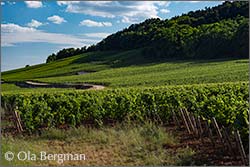 – It was a scary time. My grandfather was paying the expenses. I was selling the wine. Then in 1984, which also was bad year, my father said I had to decide whether I would carry on or not. I chose to carry on.
– It was a scary time. My grandfather was paying the expenses. I was selling the wine. Then in 1984, which also was bad year, my father said I had to decide whether I would carry on or not. I chose to carry on.
Even if previous generations had been making wine Philippe Gavignet was the first in his family to do it full-time from the start. His great-grandfather started out growing vegetables in Les Maillys near Auxonne, about a half an hour east of Nuits-Saint-Georges. But business was not booming and eventually he found himself in Vosne-Romanée, as a vineyard worker at the Domaine de la Romanée-Conti.
– So my grandfather was born at the Domaine de la Romanée-Conti, says Philippe Gavignet. He had a military career before became the manager for the Domaine des Hospices de Nuits-St-Georges, where he was involved in creating the Vente des Vins in 1962.
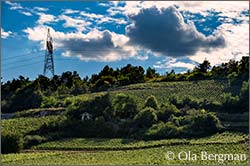 – My father was a banker. Then in 1969 my maternal grandmother died and my grandfather split the vineyards between the children. For my father that meant he could no longer just tend the vineyards over the weekends.
– My father was a banker. Then in 1969 my maternal grandmother died and my grandfather split the vineyards between the children. For my father that meant he could no longer just tend the vineyards over the weekends.
– We had 14 hectares until 1992. I worked with my uncle at Domaine Gavignet-Béthanie. We had three domaines brought together. After we split I had eight hectares.
Since then Philippe Gavignet has moved away from weedkillers and generally decreased the treatments in the vineyards.
– We are still paying for the excesses of previous generations, he says. I focus much more on terroir today. It’s the charm of Burgundy, the different climats. It’s vital that you have vineyards that are healthy.
Of the three premier crus of the domaine it is only Les Bousselots which you will find north of Nuits-Saint-Georges. It is to the immediate north of the town, next to Chaignots. The vines were planted in 1946. The soil is deep, three to four metres, with lots of clay.
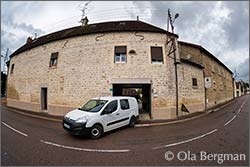 Philippe Gavignet produces two red village appellation Nuits-Saint-Georges cuvées. One is an old vines cuvée, a blend from Les Belles Croix and Les Allots. The other is a single vineyard cuvée from Les Argillats, up above Les Bousselots.
Philippe Gavignet produces two red village appellation Nuits-Saint-Georges cuvées. One is an old vines cuvée, a blend from Les Belles Croix and Les Allots. The other is a single vineyard cuvée from Les Argillats, up above Les Bousselots.
– Les Belles Croix was planted in 1926. Since then about two thirds have been re-grafted. The parcel in Les Allots is tiny, so it only makes up about 20 per cent of the cuvée. Everything is vinified together. Depending on the year I produce between 3000 and 5000 bottles.
There is also a white Nuits-Saint-Georges, Les Argillats. It is half chardonnay, half pinot blanc (the mutated pinot noir from Domaine Gouges). When Philippe Gavignet took on the parcel in 1986 it was only pinot blanc, planted in 1950.
– I didn’t want to do the same as the Gouges, he says. I planted some chardonnay and the first results were not that bad at all. It had the intensity and the flowery character of the chardonnay and the roundness of the pinot blanc.
– The pinot blanc ripens quickly and you have to be out there to pick before it becomes to heavy in character. You have two, then its too late. So I harvest the pinot blanc first. I press. At the end of the same week I harvest the chardonnay. I press and then blend the two.
© 2018 Ola Bergman










